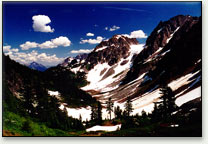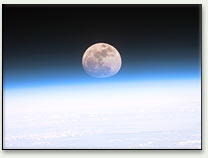A page from the "Causes of Color" exhibit...
Why is the sky blue? (scattering)

Though the day still lingers,
the rose-scattering fire of the
evening star already scintillates
through the azure sky.
– Willem Kloos, Dutch poet and essayist
The blue color of our sky is caused by scattering of light in the atmosphere.
Moonrise with blue scattering caused by earth’s atmosphere, photographed from the orbit of Space Shuttle Discovery in 1999.
Earth seen from the moon in a black sky, since there is no lunar atmosphere. This photograph was taken from the orbit of Apollo 11 in 1969.
We owe some of our most spectacular atmospheric phenomena to various types of scattering: the blue of the sky, the red of the sunset, and the white of clouds. Many blue and green feather colors involve scattering, as do many blues found in mandrills, tree frogs, and some caterpillars.
Why isn’t the sky black?
We see the sky as colored because our atmosphere interacts with the sunlight passing through it. This phenomenon is called "scattering." The type of scattering responsible for blue sky is known as Rayleigh scattering. Because this effect becomes sharply more pronounced as the energy of light increases, wavelengths at the blue end of the spectrum, where energy is the highest, are scattered preferentially. The sunlight reaching our eyes has a high ratio of short, bluish wavelengths compared to medium and long wavelengths, so we perceive the sky as being blue.
Without an atmosphere the sky appears black, as evidenced by the lunar sky in pictures taken from the moon. But even a black sky has some lightness. At night, the sky always has a faint color, called "skyglow" by astronomers. Much of this skyglow is light pollution - sources of light prevalent in urban areas that reduce our ability to see stars, planets, and other celestial phenomena.
In the absence of light from human sources, skyglow is present due to a faint airglow in the upper atmosphere (a permanent, low-grade aurora) and starlight scattered in the atmosphere. Even beyond our atmosphere, faint skyglow is caused by sunlight reflected off interplanetary dust (zodiacal light), and background light from faint, unresolved stars and nebulosity.






